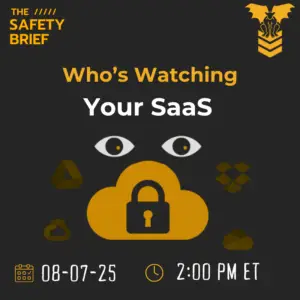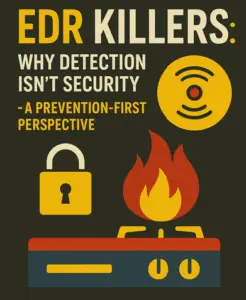There was a time when cyberattacks were messy, loud, and easy to catch. Hackers, often referred to as “script kiddies,” relied on borrowed code they barely understood. They made noise, left trails, and were usually easy to stop.
That time is over.
From Minutes to Seconds
According to CrowdStrike, in 2024, the fastest recorded cyberattack took only 51 seconds to unfold. That is barely enough time to take a sip of coffee, much less mount a defense.
We have entered an era where cyberattacks move at machine speed.
Script Kiddies Are Gone. AI Hackers Have Taken Over.
Modern threat actors do not copy code. They generate it. With the help of artificial intelligence, attackers are faster, stealthier, and far more dangerous. Nearly 80 percent of cyberattacks now involve zero malware (CrowdStrike, 2025). This means legacy detection tools that rely on malware signatures are becoming ineffective.
Today’s adversaries can adapt in real time, change tactics mid-attack, and move laterally through systems without leaving a trace.
The Cost of a Breach Keeps Climbing
The average cost of a data breach in 2024 reached 4.88 million dollars. For the financial sector, that number exceeded 6 million dollars per incident (IBM, 2024).
These costs go beyond technical fixes. Small businesses are especially vulnerable. Around 60 percent do not survive a major cyberattack.
Much of the damage stems from customer loss, brand reputation issues, regulatory fines, and legal fallout.
To make matters worse, organizations with understaffed cybersecurity teams paid an additional 1.76 million dollars per breach in 2024.
AI Is Already Being Weaponized
Artificial intelligence is not a future threat. It is already being used in active campaigns.
AI-generated phishing emails are harder to detect. Attackers can now clone voices, impersonate executives, and create personalized scams at scale. BlackMatter ransomware, for example, adjusts its behavior mid-intrusion based on the network’s defenses (Goldilock, 2025). It is like a burglar studying your alarm system while breaking into your home.
Voice-based scams powered by AI surged 442 percent in just six months (CrowdStrike, 2025).
Government Warnings Are Here
In March 2024, the U.S. Treasury publicly acknowledged that attackers are using AI to automate phishing, develop malware, and conduct reconnaissance (U.S. Department of the Treasury, 2024).
They also noted a growing concern. Larger enterprises are starting to develop their own AI defenses. Smaller organizations are relying entirely on their vendors and hoping they can keep pace.
The Global Cyber Landscape Is Escalating
Chinese-backed threat groups increased their activity by 150 percent in 2024. Some industries experienced 300 percent more attacks than the year before (CrowdStrike, 2025).
Cybercrime is expected to cost the world 24 trillion dollars by 2027 (Cyber Defense Magazine, 2025). This is more than just criminal activity. It is economic warfare.
AI Is Not Just a Threat. It Can Be a Defense.
Organizations can fight back using the same technology.
Companies that deploy AI-powered cybersecurity tools report an average savings of 2.22 million dollars per incident (IBM, 2024). These tools also help reduce breach detection and containment time by an average of 30 days.
Businesses that integrate AI into their cybersecurity strategy are more resilient, better prepared, and more trusted by their customers.
Four Actions You Can Take Today
- Respond Faster
Legacy tools are too slow. You need solutions that provide context, automation, and quick action. - Protect Identity First
Stolen credentials remain the number one entry point. Enforce multi-factor authentication and tighten password policies. - Use AI to Defend
The gap is growing between companies that use AI for defense and those that do not. Attackers are already exploiting that divide. - Build a Recovery Plan
Only 12 percent of companies fully recover from a major attack (IBM, 2024). Most are left scrambling with no clear process.
The Takeaway
Script kiddies are a thing of the past. In their place are adaptive, intelligent attackers capable of breaching systems in under a minute.
This is not a warning about the future. It is a description of today.
The real question is not whether AI will transform cybersecurity. The real question is whether your business is prepared for the threat landscape that already exists.
At BLOKWORX, we help organizations get ahead of modern threats by using proactive defense strategies that work. Let us show you how to turn today’s risk into tomorrow’s resilience.
Contact us today for a free trial of true preemptive cybersecurity.
References
Check Point Software Technologies. (2024, October 28). 2025 cyber security predictions – The rise of AI-driven attacks, quantum threats, and social media exploitation. Check Point Blog. https://blog.checkpoint.com/security/2025-cyber-security-predictions-the-rise-of-ai-driven-attacks-quantum-threats-and-social-media-exploitation/
CrowdStrike. (2025). 2025 Global Threat Report. https://www.crowdstrike.com/en-us/global-threat-report/
Cyber Defense Magazine. (2025, June 14). The growing threat of AI-powered cyberattacks in 2025. https://www.cyberdefensemagazine.com/the-growing-threat-of-ai-powered-cyberattacks-in-2025/
Fortinet. (2024). State of Cybersecurity Report 2024.
Goldilock. (2025). The emerging danger of AI-powered malware: 2025 threat forecast. https://goldilock.com/post/the-emerging-danger-of-ai-powered-malware-2025-threat-forecast
Google. (2025, July). A summer of security: empowering cyber defenders with AI. Google Safety & Security Blog. https://blog.google/technology/safety-security/cybersecurity-updates-summer-2025/
IBM. (2024). Cost of a Data Breach Report 2024. https://www.ibm.com/reports/data-breach
Kapko, M. (2025, March 5). Cybercriminals picked up the pace on attacks last year. CyberScoop. https://cyberscoop.com/cybercriminals-record-speed-attacks-2024/
SC Media. (2025, January 2). 2025 forecast: AI to supercharge attacks, quantum threats grow, SaaS security woes. https://www.scworld.com/feature/cybersecurity-threats-continue-to-evolve-in-2025-driven-by-ai
U.S. Department of the Treasury. (2024, March 27). Managing artificial intelligence-specific cybersecurity risks in the financial services sector. https://home.treasury.gov/news/press-releases/jy2212
World Economic Forum. (2025). Global Cybersecurity Outlook 2025. https://www.weforum.org/stories/2025/02/biggest-cybersecurity-threats-2025/



